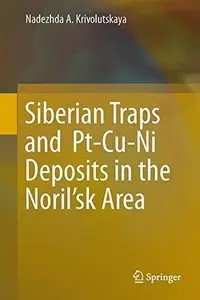Siberian Traps and Pt-Cu-Ni Deposits in the Noril'sk Area
Springer | Geochemistry | January 10, 2016 | ISBN-10: 3319172042 | 364 pages | pdf | 28.19 mb
Springer | Geochemistry | January 10, 2016 | ISBN-10: 3319172042 | 364 pages | pdf | 28.19 mb
Authors: Krivolutskaya, Nadezhda A.
Provides new geochemical data (250 LA-ICP-MS, XRF analyses) on volcanic and intrusive rocks from the Noril’sk area
Contains a huge collection of analytical data on rock-forming minerals, including main, major and rare elements (3,000 analyses)
Shows new geological results of field study of volcanic and intrusive rocks in Noril’sk region
Presents a new schema of magmatism evolution and a new model of Noril’sk deposits origin
This book addresses fundamental problems in the evolution of magmatic and ore-forming processes in the Noril’sk area of northern Central Siberia. Based on data on the geology and geochemistry of rocks, obtained by the author in the course of fieldworks and new analytical studies (applying XRF, ICP-MS, microprobe analysis, ion-probe analysis and studying melt and fluid inclusions in olivine, as well as stable and radiogenic isotopes in the rocks), it was proposed a new scheme for the evolution of magmatism, including two episodes: rift and trap per se. The ultramafic-mafic massifs are classified into three geochemical types, the most important of which (the ore-bearing Noril’sk type) was formed in post-Nadezhdinsky time as an independent pulse of magmatic activity. The primary melts for ore-bearing intrusions had tholeiitic composition with elevated MgO (8 wt%) and low volatile contents (data form melt inclusions in olivine and pyroxenes, in combination with numerical simulations using the COMAGMAT program package). The assimilation of host rocks by the parental melts was studied in the contact zones of the Maslovsky and Talnakh intrusions. It was shown that it had taken place only in narrow zones (about 1-2 m) and did not played sufficient role in ore formation. It was suggested that the source of the material was lower crustal rocks in long-lived rift zones, where sulfides accumulated in several stages.
The book offers a valuable resource for specialists in the geology of ore deposits and petrology, as well as for advanced Geology students.
Number of Illustrations and Tables
29 illus., 143 in colour
Topics
Geochemistry
Mineralogy
More info and Hardcover at Springer
Purchase a Premium account to Donate & Support :)
More Science Books …Visit my Blog :)



